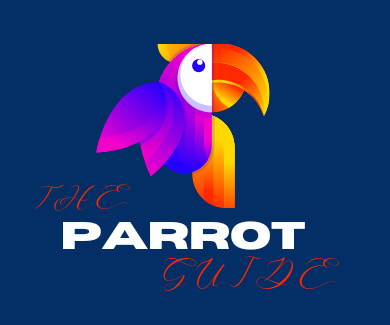Introduction of Cockatoos
We will discuss here, 9 different types of cockatoos in the world.
We are covered here with the most popular cockatoo species to keep as pets, so let’s start.
Cockatoos are mainly identified by crests on their heads and curved beak.Unlike other parrots, their plumage is not vibrant or colourful, the plumage being prominent in white and black.
They have some coloured feathers on their crest, cheeks, or tail, and size-wise they are larger than other parrots.
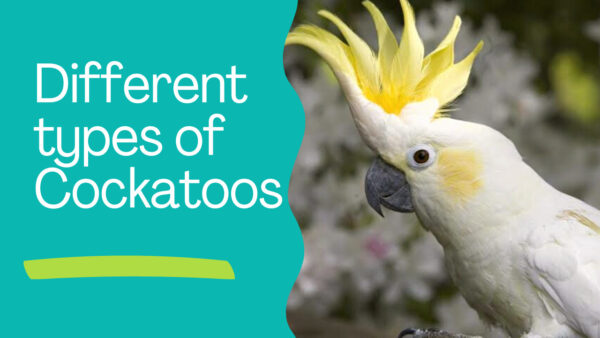
How many different types of cockatoos are there in the world?
A cockatoo belongs to 21 species of parrots Cacatuidae family.
These are the one and only family related to the superfamily Cacatuoides.
We suggest checking it from trusted sources.
Contents
All different types of Cockatoo species list
Cacatuidae
A.Calyptorhynchus
1.Red-tailed black cockatoo
2.Glossy black cockatoo
B.Zanda
1.Yellow-tailed black cockatoo
2.Carnaby’s black cockatoo
3.Baudin’s black cockatoo
C.Nymphicus
1.Cockatiel
D.Probosciger
1.Palm cockatoo
E.Callocephalon
1.Gang-gang cockatoo
F.Eolophus
1.Galah
G.Lophochroa
1.Pink cockatoo (Major Mitchell’s cockatoo or Leadbeater’s cockatoo)
HA.Cacatua- true white cockatoos
1.Yellow-crested (or lesser sulphur-crested) cockatoo
2.Citron-crested cockatoo
3.Sulphur-crested cockatoo
4.Blue-eyed cockatoo
5.White (or umbrella) cockatoo
6.Salmon-crested (or Moluccan) cockatoo
HB.Licmetis – corellas
7.Long-billed corella
8.Western corella
9.Little corella
10.Tanimbar corella (or Goffin’s cockatoo)
11.Solomons cockatoo (or Ducorps’s cockatoo)
12.Red-vented (or Philippine) cockatoo
9 Popular different types of Cockatoos
Here is the summary of some popular different types of Cockatoo parrots below
Glossy Black Cockatoo
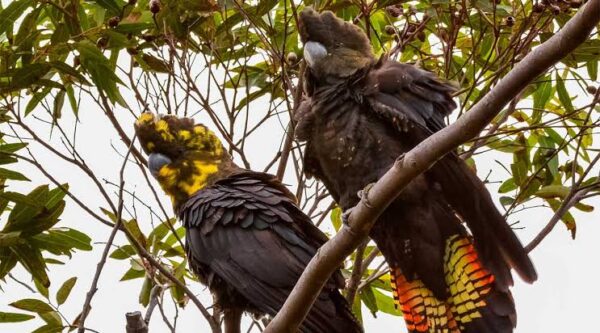
Appearance
Glossy Black Cockatoos are dimorphic sexually.
Glossy Black Cockatoos are a colour difference between the two, Males are blackish brown while females are dark brownish with some yellow spotting on their body.
Both males and females have red stripes on their tail feathers.
Diet
The Glossy Black cockatoos mainly eats seeds from various types of native trees.
These cockatoos have strong beaks, which help them to break the tree cones and extract the seeds from them.
They occasionally eat fruits, berries, nuts and often enjoy a feast of insects.
Behavior
Glossy Black Cockatoos are known for their unique behaviours, they are less vocal and alone compared to other cockatoo which set them apart from other cockatoo species.
Glossy Black Cockatoos are often seen in pairs or small family flocks. Their flight is of rapid wing flaps followed by a glide.
Glossy Black Cockatoos are also known for their nest-making behaviour, they typically build their nest on tree hollows and often prefer eucalyptus trees.
Intelligence
Glossy Black Cockatoos are considered highly intelligent birds.
Their art of extracting seeds from hard cones using their strong beaks, for which they have been seen using tools such as small sticks, shows how skilled they are at problem-solving, indicating their high level of intelligence.
Natural Habitat
Glossy black cockatoos are native to Australia, they are mainly found in specific areas of the east and southeast coasts.
Their natural habitats include open woodlands, forests, heathlands, and coastal areas.
Size and Weight
The Glossy Black Cockatoos are small in size, around size is 18 to 22 inches (45 to 55 cm) in length, and have a wingspan of about 30 to 36 inches (75 to 90 cm). They weigh between 16 to 21 ounces.
Lifespan
The Glossy Black Cockatoo has an average lifespan of around 40 to 50 years in the wild.
Baudin’s Black Cockatoo
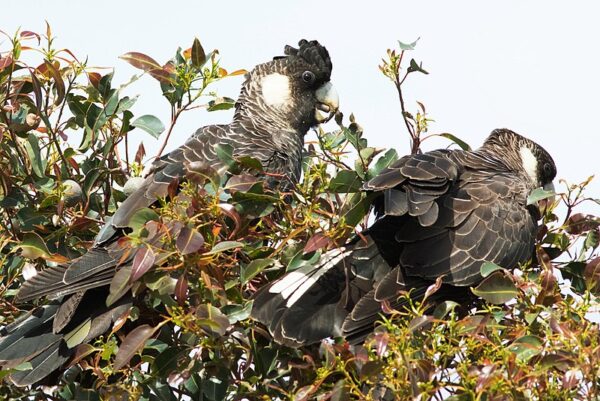
Appearance
Baudin’s black cockatoos have mainly black plumage on their body, with some white feathers around the cheeks.
On the tail “U” type pattern with white feathers. Adult males have a white patch on the upper wings, while females have a pale yellow patch.
They have a long and thin light brown beak, which is a main feature that differentiates them from other black cockatoo species.
Diet
Baudin’s Black Cockatoo eats a variety of plant-based foods including seeds, nuts, and fruits. Their diet also includes a range of native vegetation found in their habitat.
Behavior
Baudin’s Black Cockatoo are mostly seen in small family flocks.
These flocks can vary in size and may come together in larger groups during feeding or roosting.
Baudin’s Black Cockatoos are known for their distinctive volume including loud squawks, screeches and whistles.
These vocalizations are used for communication between their flocks.
They have a short crest on their heads that they can raise and lower, they can use them to communicate or display during interactions.
Intelligence
Baudin’s Black Cockatoo uses its powerful beak to break the seed to extract foods from it.
Sometimes they use wood sticks or other types of objects as a tool to extract seeds, indicating their high level of intelligence.
They are also good navigators, using these skills to search for food or nesting sites.
They learn vocalizations, imitating behaviour and actions from each other.
Natural Habitat
Baudin’s Black Cockatoos are native to southwestern Australia and are generally found in Eucalypt Woodlands, Heathlands, Forest Edges and Coastal Areas.
Size and Weight
Baudin’s Black Cockatoo is a large cockatoo species, measuring about 53 to 65 cm (21 to 26 inches) in length.
Baudin’s Black Cockatoo weighs around 450 to 800 grams or roughly 16 to 28 ounces.
Lifespan
Baudin’s Black Cockatoos’ average lifespan is around 25 to 50 years.
Cockatiel
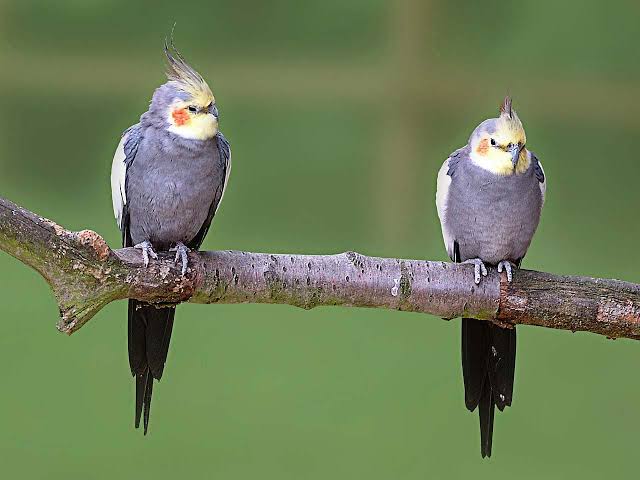
Appearance
Cockatiels come in a variety of body colours and patterns due to different mutations.
Some mutation colours include Gray, Lutino, Cinnamon, Pearl, White-faced, Pied, Yellow-cheeked, Emerald etc.
Wild type or Normal grey cockatiels have a mainly grey body with a white face and bright orange cheek patches in males, while females have a yellow colouration.
Cockatiels have a crest on their heads. This crest can be raised or lowered, indicating their mood or alertness.
Diet
In their natural habitats, Cockatiels Cockatoo can eat various fruits, nuts, seeds, grasses, berries and vegetables.
Behavior
Cockatiels are highly social birds and form strong bonds with their human companions.
They always like participating in daily basis activities.
Cockatiels bob their heads up and down for communication and expression.
It’s a way of showing love, interest and engaging with you.
Intelligence
Cockatiels are skilful in blow whistles and can also mimic melodies and sounds.
They pick up sounds from their environment and repeat them or even imitate human speech.
Cockatiels are intelligent birds. They can learn tricks, command, and mimic human speech.
Natural Habitat
Cockatiels live in grasslands, forests, and coastal areas of the Australian continent.
Size and Weight
Cockatiels size around 11 to 14 inches (28 to 36 centimetres) in length from the heads to the tips of tails.
The average weight of a cockatiel is usually between 70 to 100 grams (approximately 2.5 to 3.5 ounces).
Lifespan
Cockatiels have a relatively long life span compared to smaller parrot species.
With proper care and a healthy environment, they can live up to 15 – 20 years on average.
Palm cockatoo
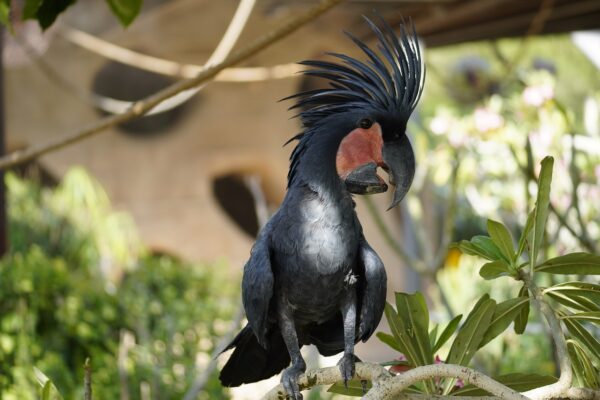
Appearance
Palm cockatoo is mainly black in colour.
It has a bright red or maroon colour pattern on its cheeks.
Palm cockatoo has a crest on its head and shows mood or emotions with the help of the Crest up and down.
Palm cockatoo’s beak is strong and slightly curved, ideal for cracking hard nuts and seeds.
Diet
The diet of the palm cockatoo mainly consists of a variety of foods found in its native rainforest habitat.
Palm cockatoo eats various types of fruits, seeds, nuts, tree leaves, and flowers, and sometimes eats insects and larvae.
Behavior
One of the most unique behaviours of the Palm Cockatoo is its drumming behaviour.
They seek to impress females when nesting in hollow trees.
The wooden stick is struck on the tree rhythmically, producing a characteristic drum sound.
This behaviour is for their communication and courtship.
Intelligence
Palm cockatoos have been observed using instruments such as tree sticks to drum in hollow trees to impress females in the wild.
They are known for their vocalizations, which include a wide range of calls, whistles, and drumming sounds.
They can mimic a variety of natural sounds, their have ability to learn and imitate complex sounds.
Natural Habitat
The Palm Cockatoo is native to the rainforests and wooded habitats of northern Australia, New Guinea, and nearby islands. Its often seen in Tropical Rainforests, Woodlands, and Coastal areas.
Size and Weight
Palm Cockatoos’ size is 20 to 25 inches (50 to 64 cm) in length from the heads to the tips of tails.
The average weight of Palm Cockatoo is between 900 to 1300 gm (32 to 46 oz).
Lifespan
Palm Cockatoo live up to 40 to 60 years in the wild.
Gang-gang cockatoo
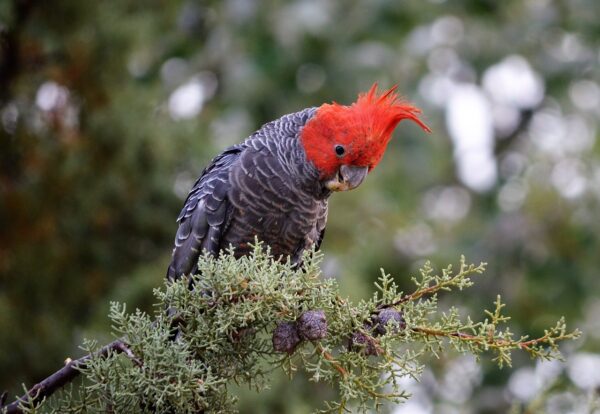
Appearance
Gang-gang cockatoos are sexually dimorphic in colour.
Head and creat colour is different in males and females. Males have a bright red head and crest male, while females have a greyish-brown head and crest.
Juvenile Gang-gang Cockatoos generally look like adult females, with a greyish-brown head and body.
Their crest will be fully developing by the time they reach adulthood.
Both male and female Gang-gang Cockatoos have grey plumage on their bodies.
Their wings and back are a mixture of dark grey and lighter grey feathers, giving them a spotted appearance.
A belly and chest, are generally lighter in colour.
Gang-gang Cockatoos have a long, pointed tails with grey feathers.
Their beaks are relatively short and curved, which is characteristic of cockatoo species.
Diet
Gang-Gang cockatoo eats various foods, including seeds and nuts, fruits and berries, flowers, and something ears insects and larvae.
Behavior
Gang-gang Cockatoos are social birds, and are often seen in medium flocks. They use vocalizations and body language for interaction.
During breeding season Gang-gang Cockatoos show nesting behaviour and become more territorial.
They make nests in tree hollows, Both the male and female work together to prepare the nesting site and incubate the eggs.
The Gang-gang Cockatoo use their crest as a signal of their emotional state.
They raise their crest when excited, curious or alarmed, and lower it when calm or resting.
Intelligence
Gang-gang Cockatoo are known for their ability to mimic, including human speech. They can learn to repeat various sounds.
Gang-gang cockatoos adopted environment changes, and they can find food in human areas, such as from a bird lover or feeder.
Natural Habitat
Gang-gang Cockatoos are native to the southeast and eastern parts of Australia. It’s often seen in woodlands, eucalyptus jungles, and even urban areas where nesting and feeding are possible.
Size and Weight
Gang-gang Cockatoos’ size is 30 to 35 cm (12 to 14 inches) in length from head to tail.
Gang-gang Cockatoos weigh up to 300 – 400 gm (10.5 – 14 oz).
Lifespan
Gang-gang Cockatoos can live up to 20 to 40 years in wildlife.
Galah
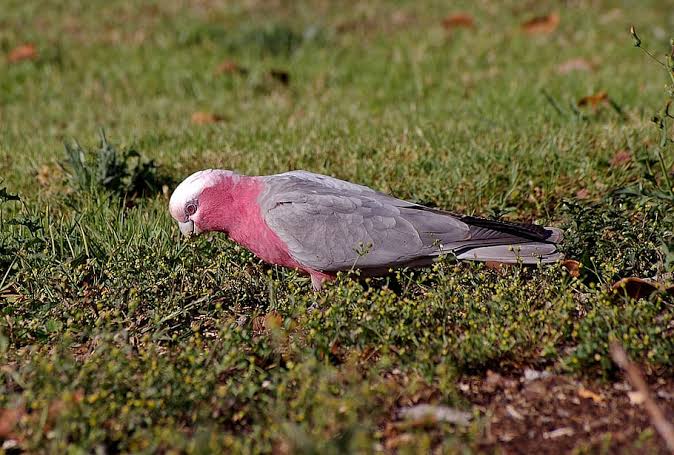
Appearance
Galahs have a distinct pink face and chest, which contrasts with their grey body and wings.
The combination of pink crest, face and chest with brown plumage makes them easily recognizable.
The overall plumage of the galah is light brown, they have a pink crest on the top of their head, face and chest are dark pink, giving them the nickname “Rose-breasted”.
There are pale pink and silver spots on the wings feathers.The tail is long and has brown feathers. Their beak is short and thick.
Diet
The Galah eats plant-based foods Containing seeds & nuts, fruits & berries and flowers & Vegetation. Galahs may also eat insects and insect larvae.
Behavior
Galahs are social birds and are often seen in flocks.
These flocks can be seen together in small groups to large groups around food and water sources.
Galahs are known for their noisy and talkative nature.
They have a wide range of voices, including squawks, screeching and whistling.
They use their vocalizations to communicate with the flock, establish territory, and alert others to potential threats.
Intelligence
Galahs uses vocalizations, body language even wing-flapping to communicate with each other.
They can learn to act different tricks and tasks and are capable of adapting to environmental change.
They do many playful activities like hanging upside down, swinging, and doing aerial acrobatics,it shows their level of curiosity and creativity.
Natural Habitat
Galah lives in woodlands, grasslands, savannas, and agricultural areas of Australia. They are also seen in public parks or gardens.
Size and Weight
Galahs are medium size cockatoos. Their length up to 35 to 36 cm (14 inches).
Galahs weight up to 300 to 350 gm (10.5 to 12.3 oz).
Lifespan
Galahs can live up to 20 to 30 years in wildlife.
Pink Cockatoo (Major Mitchell’s Cockatoo)
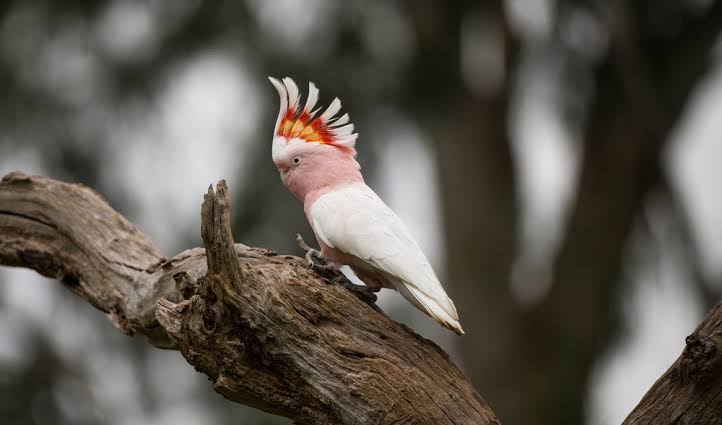
Appearance
Pink cockatoos have a pink colour on face, neck and upper chest, and other feathers are Cream in colour. The underside of their wing also has pink feathers, visible only when they fly, giving them a unique look. There is a red and yellow design on their crest.
Diet
The diet of Major Mitchell’s cockatoo is omnivorous, and it contains a variety of foods, including seeds and nuts, fruits and berries, flowers and insects which give them additional protein, especially during the breeding season.
Behavior
Major Mitchell’s cockatoos are often seen in small flocks or pairs, they form a strong bond with their mates.
Their behaviour is playful, they do activities like hanging upside down and showing aerial acrobatics.
They are not as noisy as some other cockatoo species, they are capable of making a variety of calls and vocalizations.
They raise and lower their crest during courtship to communicate emotion, excitement or show off.
Intelligence
Major Mitchell’s cockatoos are known for their intelligence.
They can problem-solve, learn new methods and adapt to different situations.
And they are able to learn to imitate sounds. They can mimic a wide variety of sounds, including human speech and environmental noises.
Natural Habitat
Major Mitchell’s cockatoos are native to various regions of Australia, including open forests, dry areas, and shrublands.
Size and Weight
They are medium-sized cockatoos with an average length of about 40 to 50 cm (16 to 20 inches).Major Mitchell’s Cockatoos weigh around 400 to 600 grams (14 to 21 ounces).In the wild, they generally have a lifespan of around 40 to 60 years.
Lifespan
In the wild, they generally have a lifespan of around 40 to 60 years.
White (or Umbrella) Cockatoo
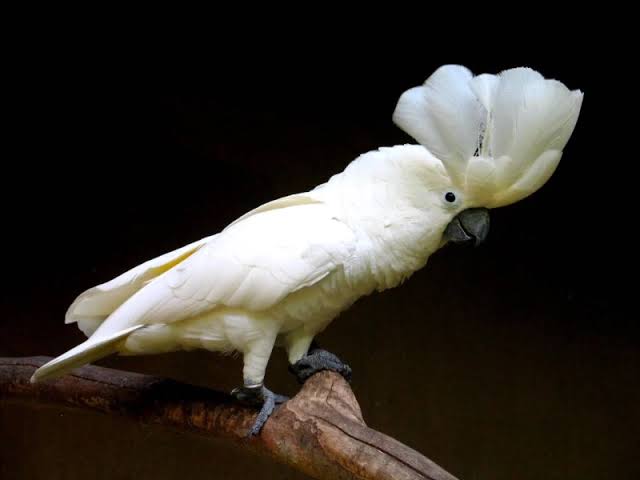
Appearance
The plumage of adults is predominantly white, with some variation in shades of yellow on the lower wings and tail.
Their eyes are black, and their beak is big and curved.
Diet
In the wild, their diet includes a variety of seeds, nuts, fruits, berries, and vegetation.
Behavior
Umbrella cockatoos are very social birds and tend to form strong bonds with their human caretakers.Social interaction and mental stimulation are necessary for them.
Umbrella cockatoos are capable of making loud sounds that include screeching, squawks, and whistling.They vocalise all time for communication and expressing emotions.
Intelligence
Umbrella cockatoos are known for their intelligence and ability to learn tricks, behaviours, and even vocabulary.
They adopted environmental changes and developed problem-solving skills.
Natural Habitat
The white cockatoo’s natural habitats are rainforests and forested areas of Indonesia and Papua New Guinea.
Size and Weight
Umbrella cockatoos are medium to large in size, and their size is up to 46 to 50 cm (18 to 20 inches) in length.
White Cockatoos typically weigh around 600 to 900 grams (21 to 32 ounces).
Lifespan
Umbrella cockatoos have a lifespan of around 40 to 60 years.
Little corella
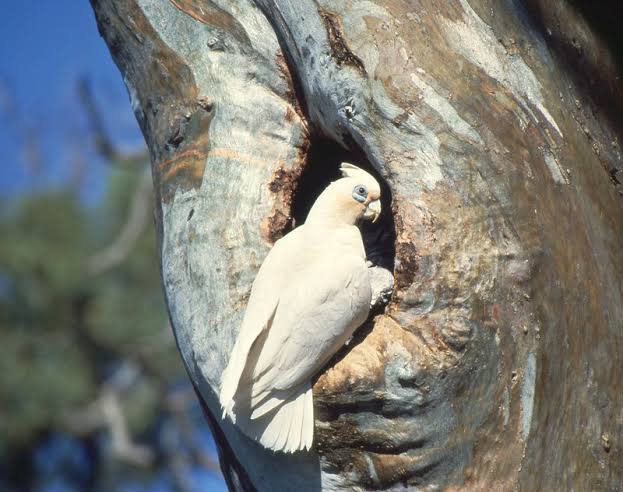
Appearance
Their plumage is mainly white and they have a pale pink or peach color on their face and chest. Little corella have a small, backward-curving crest on the top of their heads.
Diet
Little corella eats seeds, grains, fruits, nuts, and vegetation in the wildlife.
Behavior
Little Corellas are very social birds and are often seen in large flocks.
They are very playful in nature, they do activities like hanging upside down, swinging and manipulating objects.
Intelligence
Little corella is not known for having problem-solving skills like some other parrot species, but Little Corellas are considered to be intelligent birds capable of learning tricks and behaviours.
Natural Habitat
The little corella’s natural habitats are forests, grasslands, and agricultural fields in Australia.
They are also seen in urban areas.
Size and Weight
Little Corella is a relatively small cockatoo, averaging around 36 to 39 cm (14 to 15 inches) in length. The smaller Corella weighs around 400 to 600 g (14 to 21 oz).
Lifespan
The little corella life span in the wild is about 20 to 40 years.
FAQ
What is a cockatoo?
Cockatoos are parrots has a crest of feathers on their head which separates them from other parrots species.
What is the rarest colour cockatoo?
Palm Cockatoos are the rarest and most unique Cockatoos.
Are Cockatoos only white?
No, Cockatoos are white, grey, black, pink, and combinations of other colours.
What is the Largest Cockatoo?
Moluccan Cockatoo is the largest cockatoo, also known as the Salmon-crested Cockatoo.
Conclusion
Cockatoos are one of the species of parrots. They have different appearances and behaviour, with their crest being the identity of a cockatoo.
They are intelligent and social birds. They eat seeds, fruits, nuts, and sometimes insects.
Cockatoos are different species, and each has a different size and colour, and they live in open woodlands, forests, heathlands, and coastal areas.
